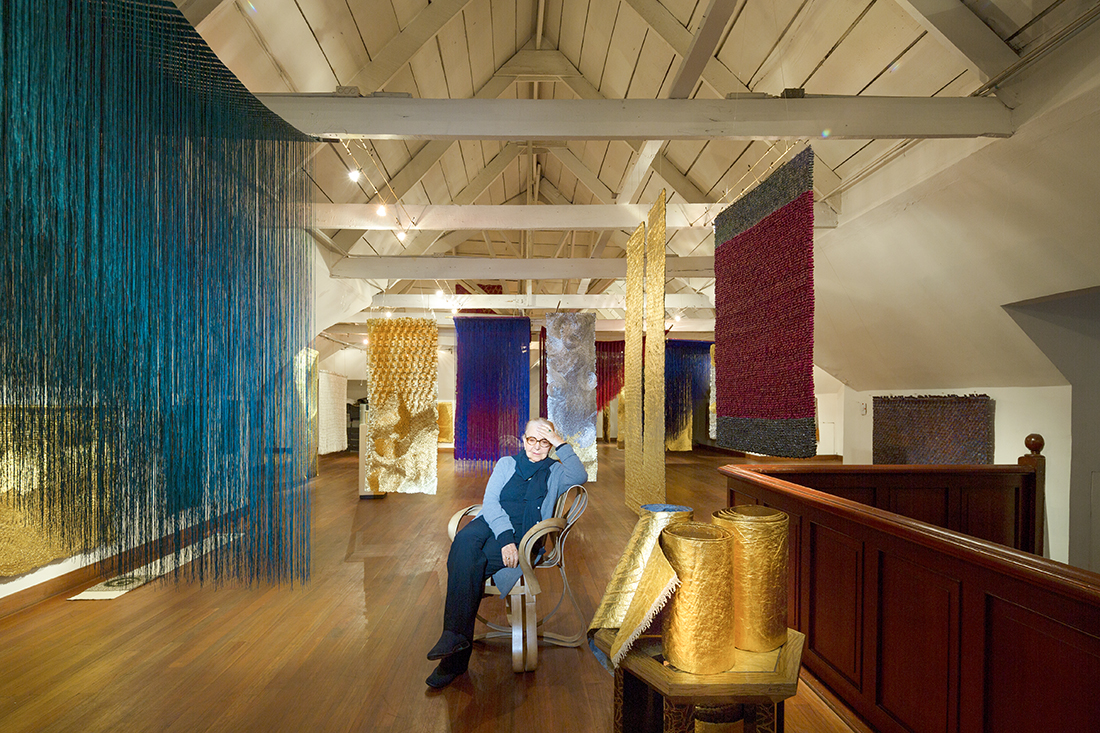
«Al construir superficies, creo espacios de meditación, contemplación y reflexión. Cada pequeña unidad que forma las superficies no solo es significativa por sí misma, sino que también resuena profundamente con el todo. De igual manera, el todo resuena profundamente con cada elemento individual.»
Olga de Amaral
«As I build surfaces, I create spaces of meditation, contemplation, and reflection. Each small unit that forms the surfaces is not only significant in itself but also deeply resonates with the whole. Likewise, the whole resonates deeply with each individual element».
Olga de Amaral
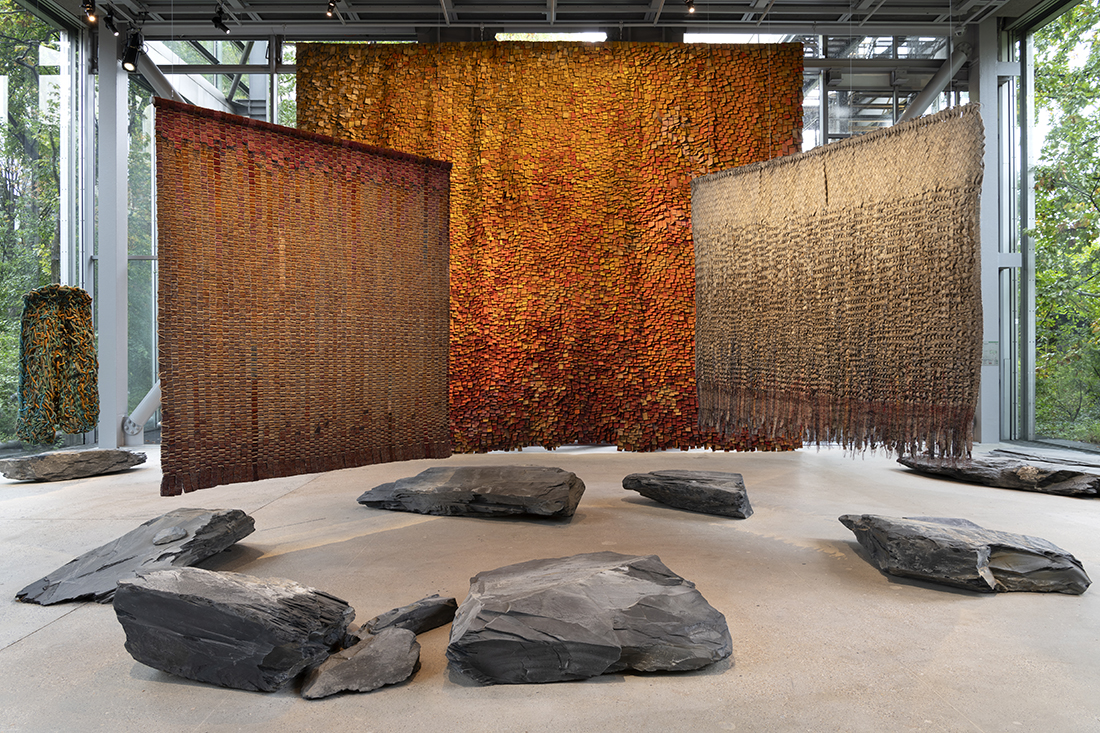
Olga de Amaral es conocida actualmente como una de las artistas clave en la evolución y desarrollo del arte experimetal y textil en Colombia. Nacida en Bogotá el 10 de junio de 1932, Amaral estudió diseño arquitectónico en el Colegio Mayor de Cundinamarca, y más tarde se formó en arte textil en el Cranbrook Academy of Art en Estados Unidos, lo que marcaría profundamente su enfoque artístico. Descubrió la posibilidad de los hilos y textiles en el taller de Marianne Strengell, una influyente diseñadora textil modernista finlandesa-estadounidense del siglo XX quien traducía patrones de fibra tejidos a mano para la producción mecanizada, y fue pionera en el uso de fibras sintéticas.
Olga de Amaral is currently recognized as one of the key artists in the evolution and development of experimental and textile art in Colombia. Born in Bogotá on June 10, 1932, Amaral studied architectural design at Colegio Mayor de Cundinamarca and later trained in textile art at Cranbrook Academy of Art in the United States, which would profoundly shape her artistic approach. She discovered the potential of threads and textiles in the workshop of Marianne Strengell, a 20th-century Finnish-American modernist textile designer who translated hand-woven fiber patterns for mechanized production and pioneered the use of synthetic fibers.
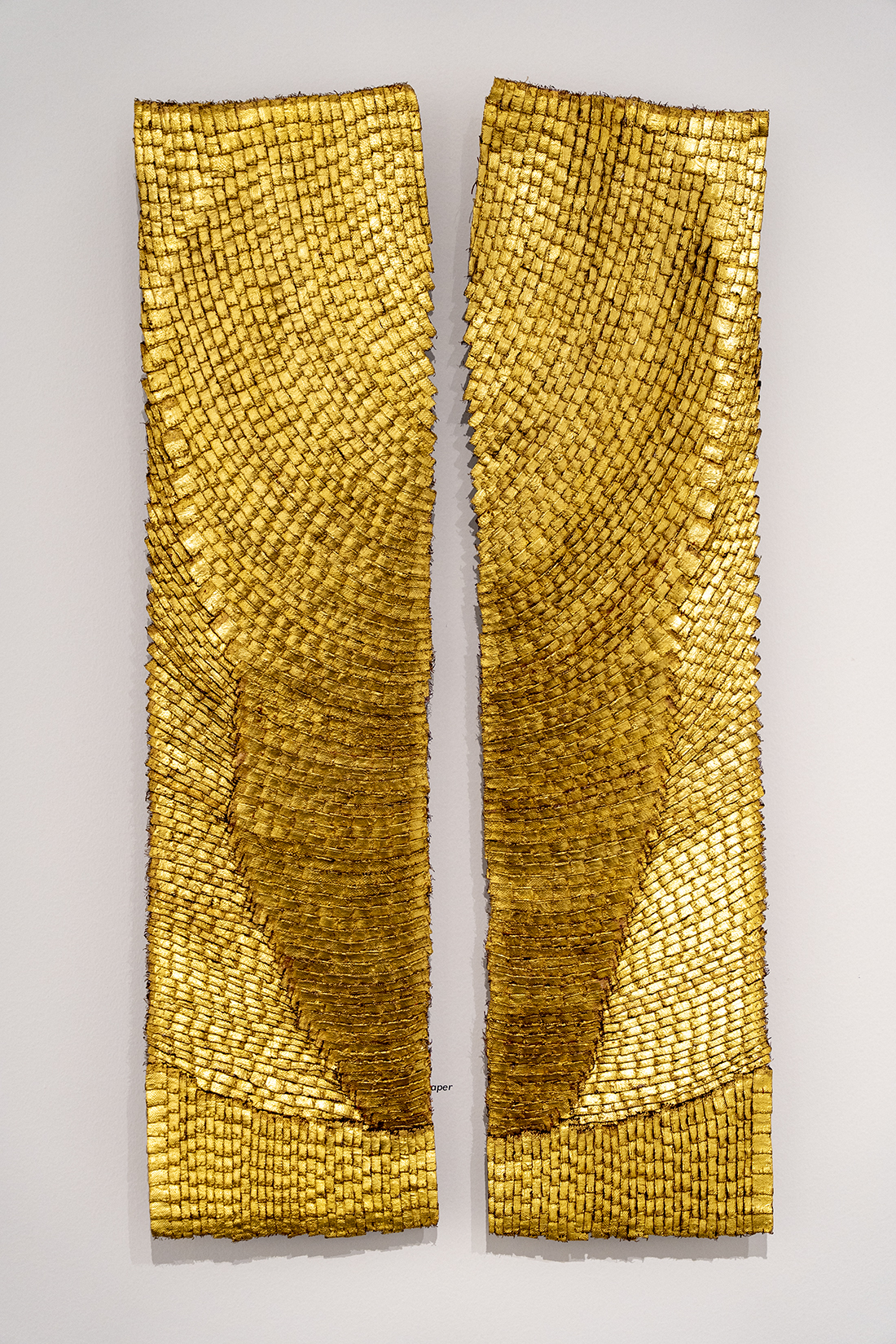
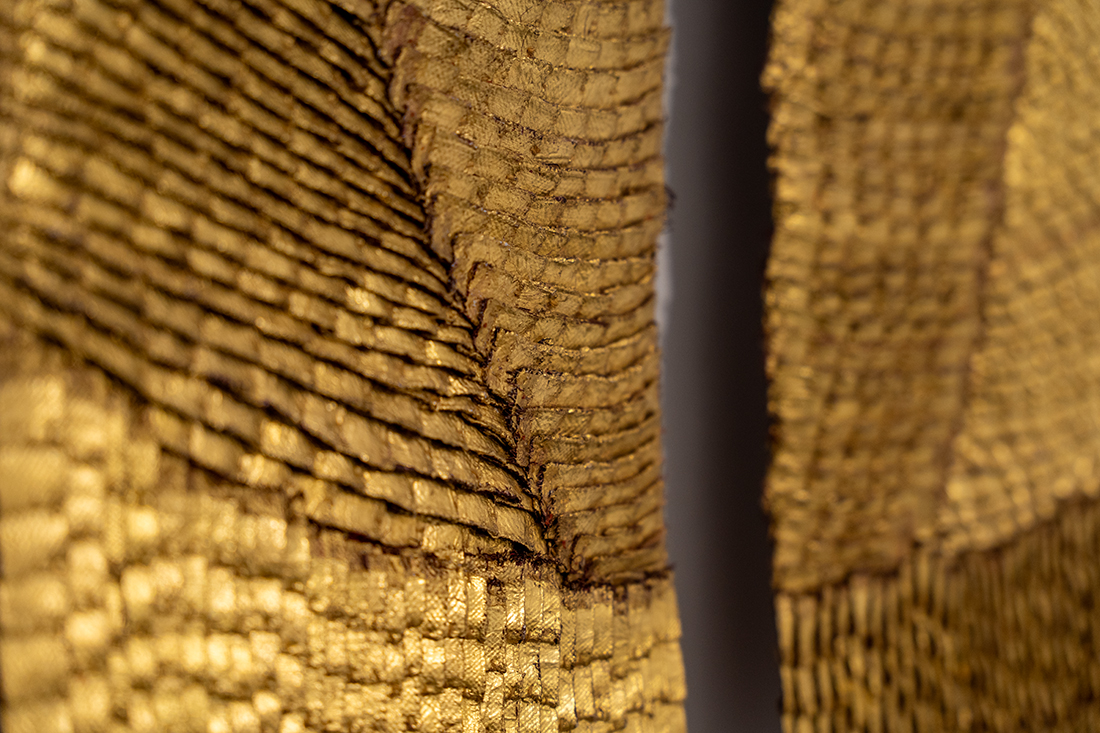
Su obra se caracteriza por la creación de piezas donde se desdibujan los límites entre el arte bidimensional y tridimensional, la pintura y el tejido y el arte y el diseño, donde utiliza fibras, hilos y metales como el oro y la plata. Por lo mismo, su trabajo ha evolucionado más allá del arte textil tradicional, incorporando técnicas de tejido ancestral con enfoques contemporáneos que evocan paisajes, arquitectura y formas orgánicas donde la belleza formal de las piezas es acentuada con el protagonismo de los formatos. Así mismo, el uso del oro en sus obras, evoca una conexión importante con la tradición precolombina, al mismo tiempo que añade un componente de espiritualidad y luz al cuerpo total de su trabajo.
«Yo no hago escultura ni cuadros tejidos, como alguna vez llamaron a mi obra. Hasta cierto punto por fin llegué a la palabra que define lo que hago: presencias».
Her work is characterized by the creation of pieces where the boundaries between two-dimensional and three-dimensional art, painting and weaving, and art and design are blurred, using fibers, threads, and metals such as gold and silver. As a result, her work has evolved beyond traditional textile art, incorporating ancestral weaving techniques with contemporary approaches that evoke landscapes, architecture, and organic forms, where the formal beauty of the pieces is accentuated by the prominence of their formats. Likewise, the use of gold in her works evokes a significant connection to the pre-Columbian tradition, while also adding a component of spirituality and light to the body of her work.
«I do not make sculptures or woven paintings, as my work was once called. To a certain extent, I have finally arrived at the word that defines what I do: presences.»
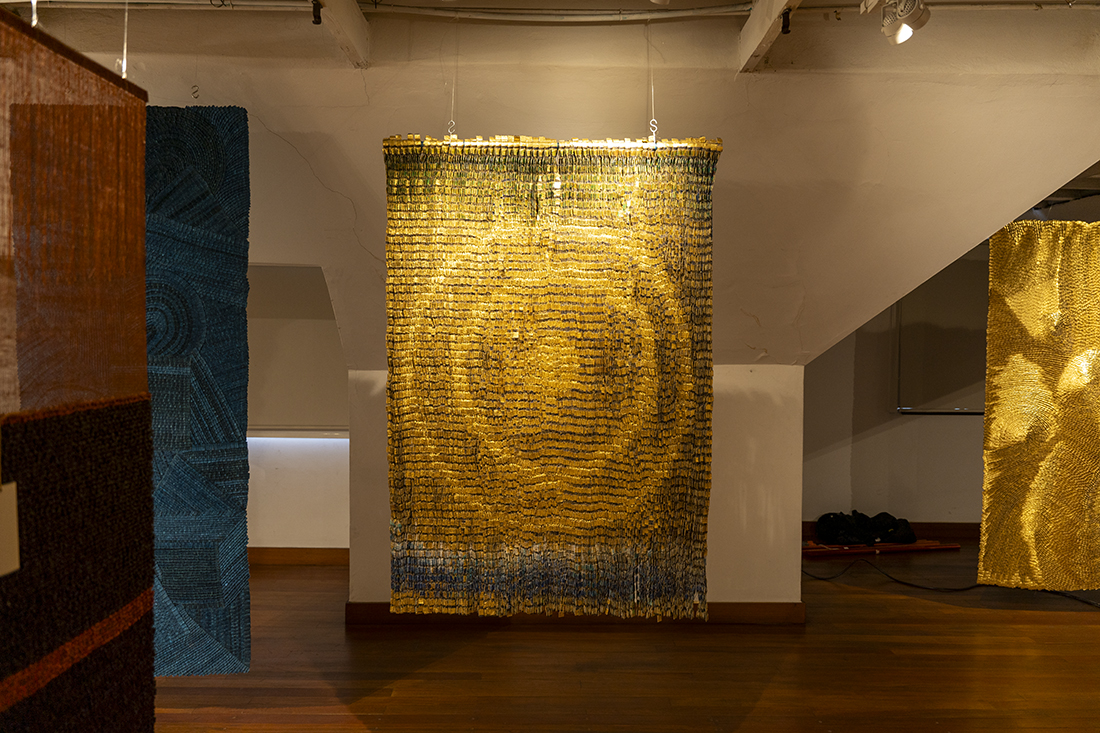
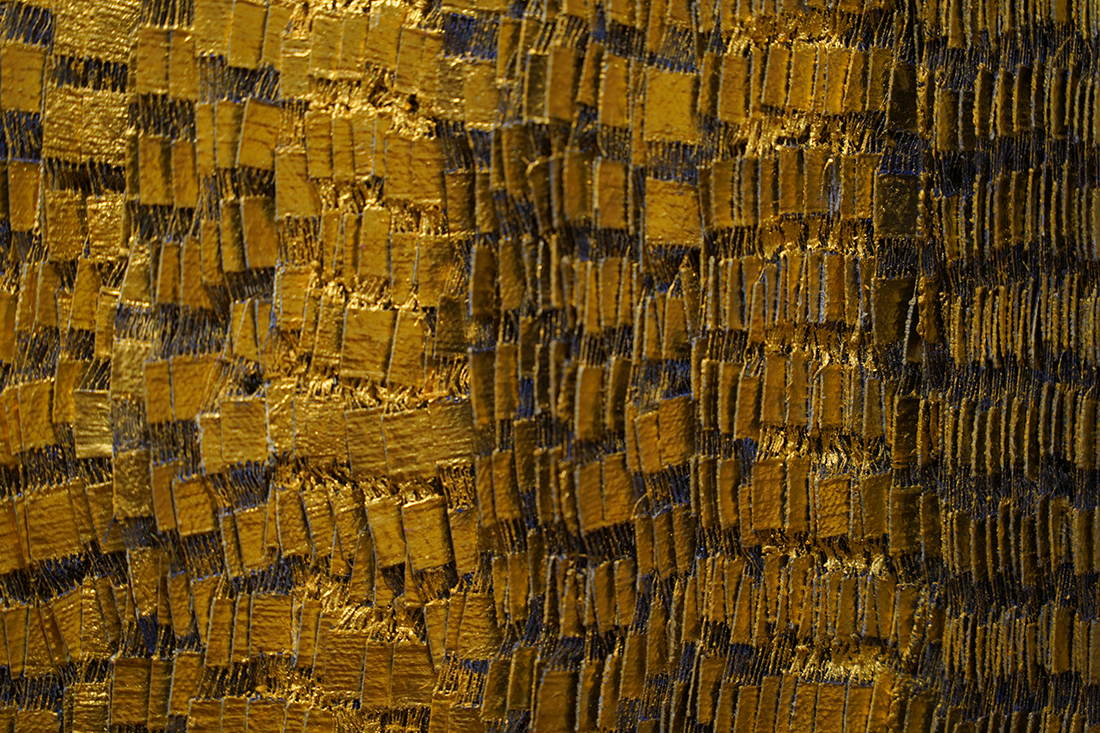
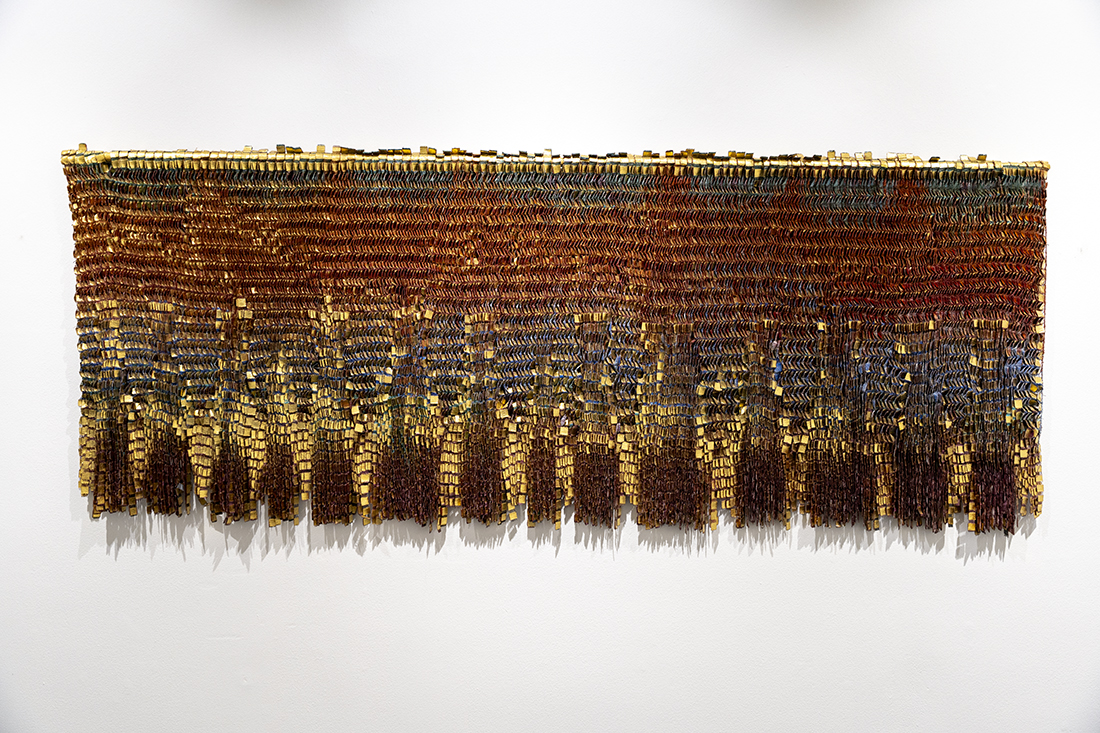
Durante los años 60 y 70, junto a artistas destacadas como Sheila Hicks y Magdalena Abakanowicz, contribuyó al desarrollo del arte textil y de fibras, utilizando nuevos materiales y técnicas, inspirándose tanto en los principios modernistas como en las tradiciones populares, lo que resultó en la creación de una obra que combina innovación con herencia cultural expandiendo los límites del arte textil hacia el ámbito de la escultura y la instalación, manteniendo una profunda conexión con las tradiciones artesanales colombianas. Gran parte de estas cualidades la han hecho merecedora de diversos premios a lo largo de su trayectoria: en 1973, fue galardonada con la prestigiosa Beca Guggenheim, lo que le permitió continuar expandiendo su investigación en el arte textil. En 2005, recibió el Premio Nacional de Artes Plásticas de Colombia, uno de los más importantes del país. En 2008, el Ministerio de Cultura de Colombia le otorgó el Premio Vida y Obra, destacando su legado y aportes al arte contemporáneo colombiano.
During the 1960s and 70s, alongside prominent artists like Sheila Hicks and Magdalena Abakanowicz, she contributed to the development of textile and fiber art by using new materials and techniques, drawing inspiration from both Modernist principles and popular traditions. This resulted in the creation of work that combines innovation with cultural heritage, expanding the boundaries of textile art into the realms of sculpture and installation, while maintaining a deep connection to Colombian artisanal traditions. Many of these qualities have earned her numerous awards throughout her career: in 1973, she was awarded the prestigious Guggenheim Fellowship, which allowed her to continue expanding her research in textile art. In 2005, she received the National Prize for Visual Arts of Colombia, one of the country’s most important awards. In 2008, Colombia’s Ministry of Culture awarded her the Lifetime Achievement Award, highlighting her legacy and contributions to contemporary Colombian art.
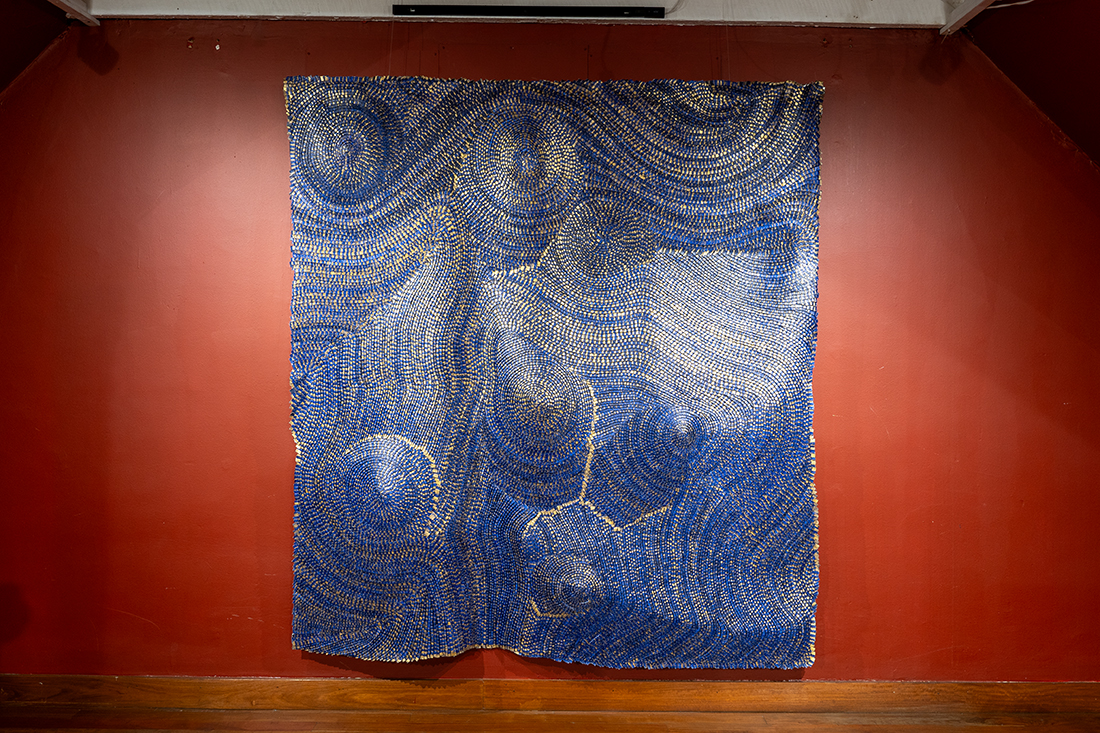
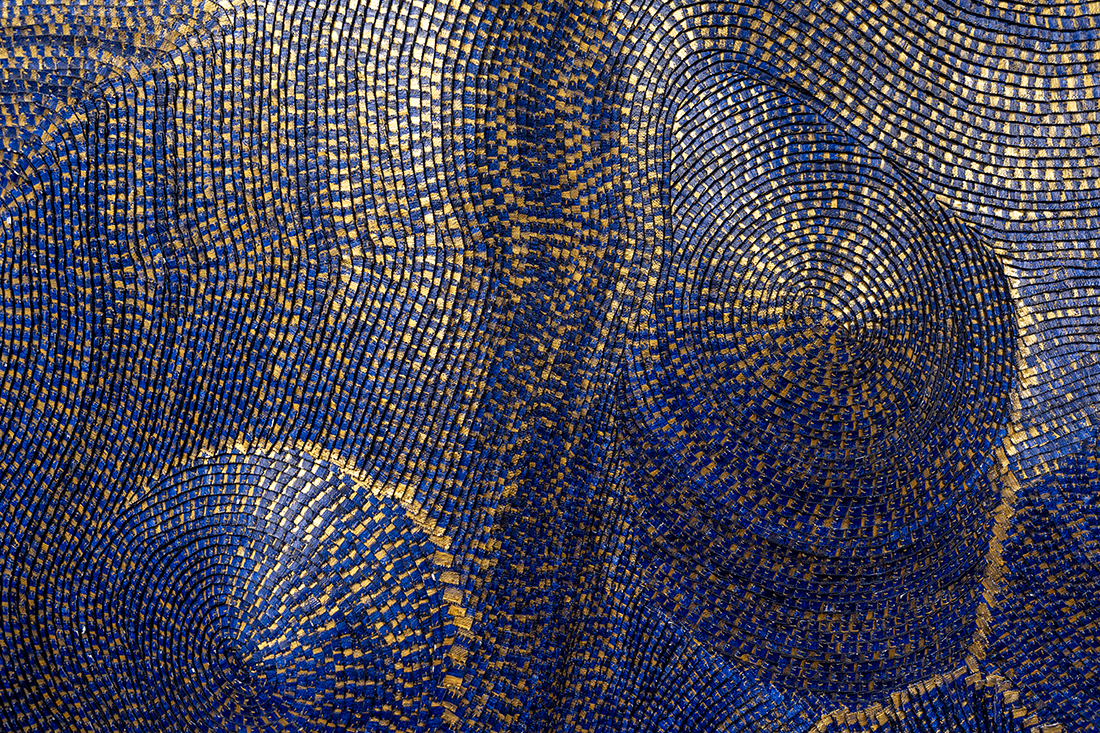
Exposición
Fondation Cartier pour l’art contemporain
La exposición de Olga de Amaral en la Fundación Cartier, comisariada por Marie Perennès y diseñada por la arquitecta Lina Ghotmeh, marca un hito en la celebración de una de las figuras más influyentes del arte colombiano contemporáneo. A sus 92 años, de Amaral ha forjado una trayectoria artística que trasciende las fronteras entre pintura, escultura y textiles, consolidándose como una voz fundamental en el diálogo entre arte y materialidad. La muestra presenta cerca de 80 obras que abarcan más de seis décadas de su carrera, incluyendo pinturas, esculturas, instalaciones y estructuras arquitectónicas que no solo invitan a la contemplación, sino que envuelven al espectador en un universo inmersivo y sensorial.
The exhibition of Olga de Amaral at the Cartier Foundation, curated by Marie Perennès and designed by architect Lina Ghotmeh, marks a milestone in celebrating one of the most influential figures in contemporary Colombian art. At 92 years old, de Amaral has built an artistic trajectory that transcends the boundaries between painting, sculpture, and textiles, establishing herself as a key voice in the dialogue between art and materiality. The exhibition features nearly 80 works spanning more than six decades of her career, including paintings, sculptures, installations, and architectural structures that not only invite contemplation but also envelop the viewer in an immersive and sensory universe.
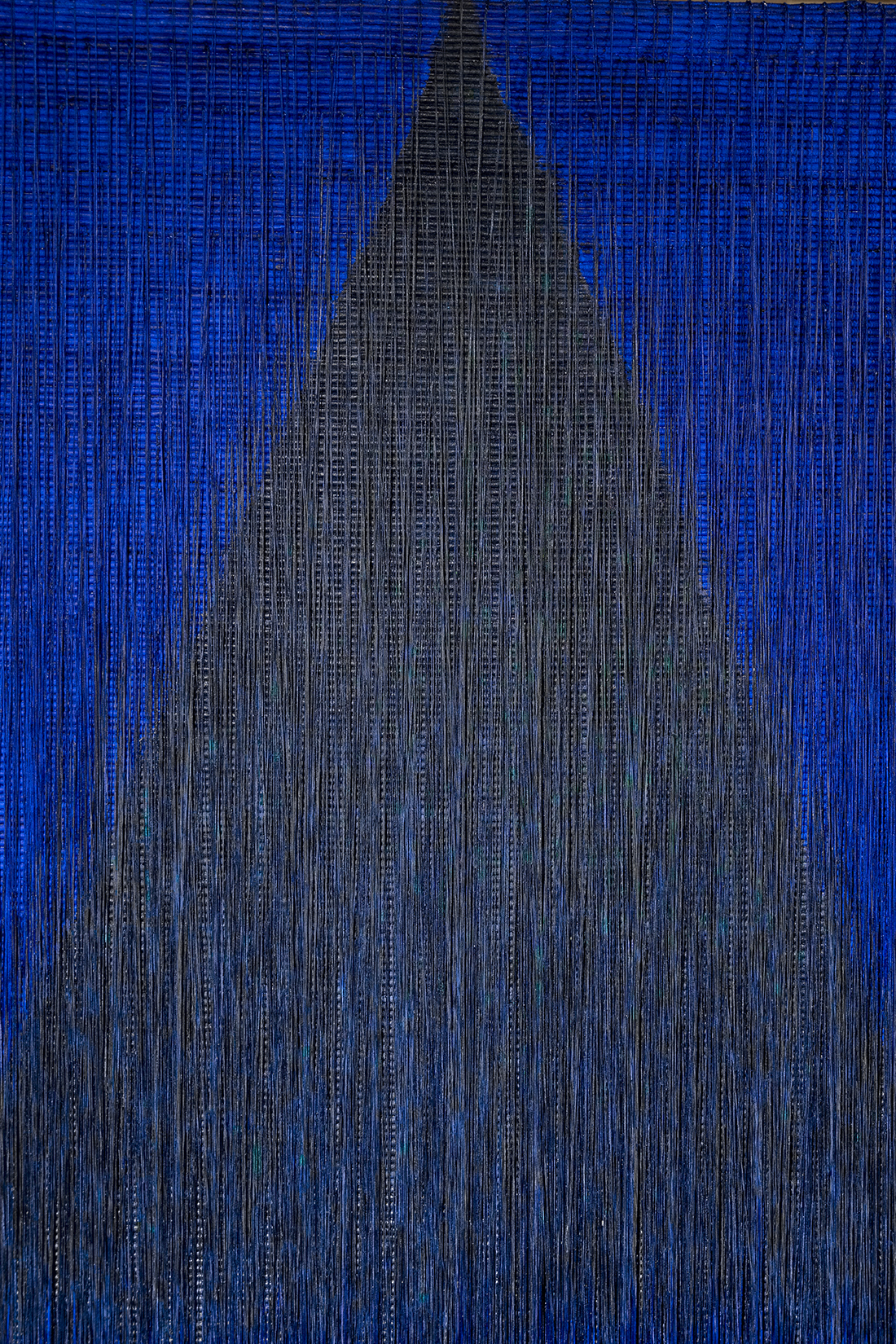
El guion expositivo revela una amplia gama de formatos, desde pequeñas obras que sirven como estudios a piezas más monumentales, hasta complejas instalaciones que plantean la relación entre arte y espacio. En esta exposición que estará abierta al público hasta el 16 de marzo de 2025, aspectos menos explorados de su obra como su profunda conexión con el paisaje colombiano, cobran protagonismo, donde las texturas y colores dialogan con la arquitectura, mientras capas de textiles entrelazados evocan paisajes naturales, muros de ladrillo y estratos geológicos.
The curatorial script reveals a wide range of formats, from small works that serve as studies to more
monumental pieces, as well as complex installations that explore the relationship between art and space. In this exhibition, open to the public until March 16, 2025, lesser-explored aspects of her work, such as her deep connection with the Colombian landscape, take center stage. Here, textures and colors engage in dialogue with the architecture, while layers of interwoven textiles evoke natural landscapes, brick walls, and geological strata.
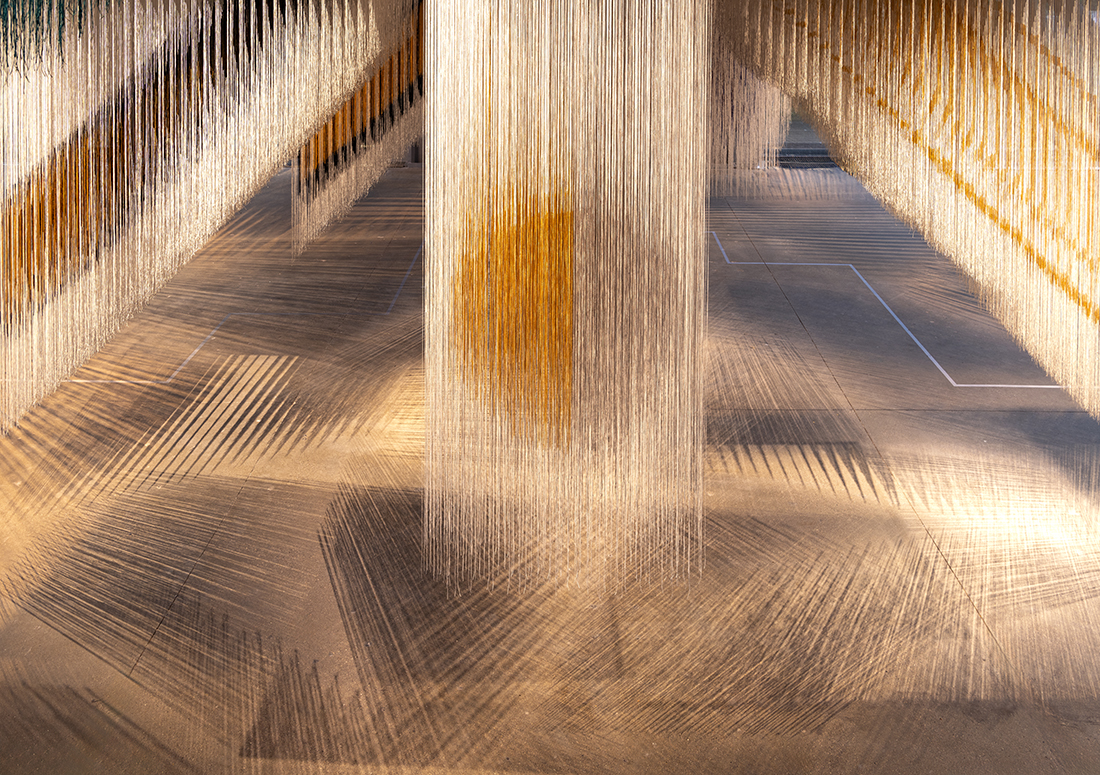
Vista de la exposición Olga de Amaral en la Fundación Cartier, 2024. Photo: Marc Domage.Olga de Amaral quien fue nombrada “Artista Visionaria” por el Museo de Arte y Diseño de Nueva York en 2005, y galardonada con el Premio a la trayectoria artística del Women’s Caucus for Art en 2019, continúa demostrando con esta exposición su capacidad de innovar y transformar la percepción del arte textil y escultórico. La muestra no solo destaca la riqueza visual y la profundidad conceptual de su obra, sino que también rinde homenaje a su incansable labor por redefinir los límites del arte contemporáneo.
Olga de Amaral, who was named a “Visionary Artist” by the Museum of Arts and Design in New York in 2005, and awarded the Lifetime Achievement Award by the Women’s Caucus for Art in 2019, continues to demonstrate with this exhibition her ability to innovate and transform the perception of textile and sculptural art. The show not only highlights the visual richness and conceptual depth of her work but also pays tribute to her tireless efforts to redefine the boundaries of contemporary art.

EXCLAMA ha contactado a Marie Perennès curadora de la muestra y esto pudo contarnos acerca de la exposición:
¿Qué criterios se utilizaron para seleccionar las obras de Olga de Amaral para esta exposición en la Fundación Cartier?
La exposición reúne casi 80 obras creadas entre la década de 1960 y hoy. Aunque la muestra no puede ser representativa de toda la carrera de Olga de Amaral —ella ha creado más de 1,600 piezas—, esperamos ofrecer una visión de la riqueza y diversidad de su increíble trabajo. Presentamos obras de pequeño formato, algunas de las cuales se consideran casi estudios, preludios de otras piezas, mientras que otras son de escala monumental y compiten con la arquitectura de la Fundación Cartier.
EXCLAMA has contacted Marie Perennès, the curator of the exhibition, and she shared the following with us about the show:
What criteria were used to select Olga de Amaral’s works for this exhibition at the Cartier Foundation?
The exhibition brings together nearly 80 works created between the 1960s and today. Although the show cannot be fully representative of Olga de Amaral’s entire career—she has created over 1,600 pieces—we hope to provide a glimpse into the richness and diversity of her incredible work. We feature small-format works, some of which are considered almost studies, preludes to other pieces, while others are of monumental scale, interacting with the architecture of the Cartier Foundation.
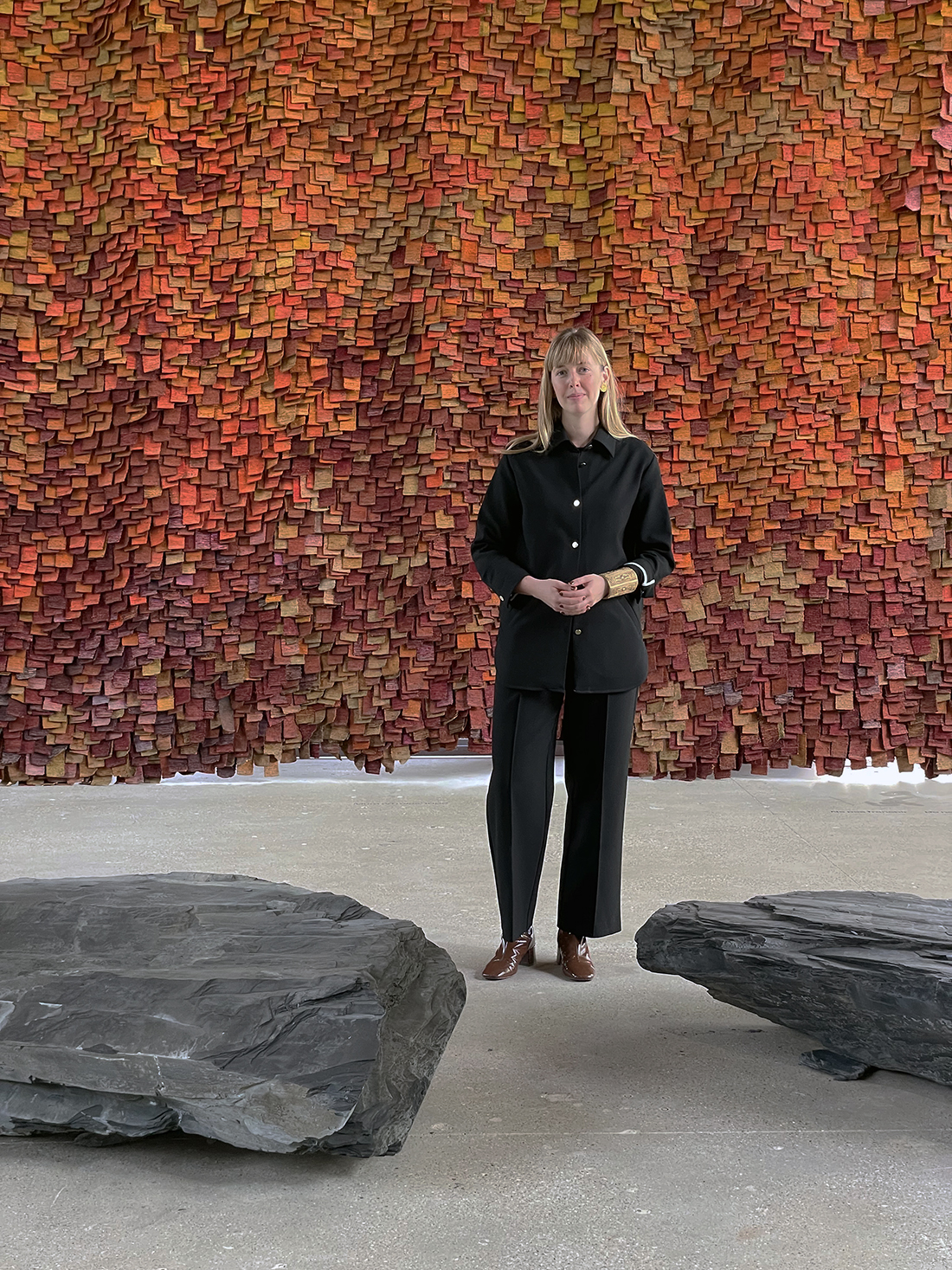
¿Cuál es el enfoque curatorial de la exposición y cómo se relaciona con el legado de Olga de Amaral en el arte contemporáneo?
El enfoque curatorial de la exposición rinde homenaje a cómo, a partir de las décadas de 1960 y 1970, Olga de Amaral buscó posicionar el arte textil dentro del campo del arte contemporáneo. Contribuyó al auge del Fiber Art y al reconocimiento del textil como un medio artístico autónomo e independiente, ya no subordinado a la arquitectura. En la exposición, las obras de Olga se liberan de la pared. Configuran el espacio, creando ellas mismas el recorrido del visitante.
What is the curatorial approach of the exhibition, and how does it relate to Olga de Amaral’s legacy in contemporary art?
The curatorial approach of the exhibition pays tribute to how, starting in the 1960 s and 1970 s, Olga de Amaral sought to position textile art within the field of contemporary art. She contributed to the rise of Fiber Art and to the recognition of textil as an autonomous and independent artistic medium, no longer subordinated to architecture. In the exhibition, Olga’s works are freed from the walls. They shape the space, creating the visitor’s path themselves.
¿Qué aspectos de su trabajo pretende destacar esta exposición que quizás no hayan sido explorados en exposiciones anteriores?
Todo el piso principal de la exposición se centra en la conexión de Olga de Amaral con el paisaje, un aspecto de su trabajo que aún no se había explorado. Obras monumentales como Muro en rojo y Gran Muro, por ejemplo, evocan los muros de ladrillo típicos de las construcciones colombianas o las hojas caídas cuando se extienden en el suelo. Cada una de estas piezas se convierte en un paisaje en sí mismo. Las superficies de las obras, construidas a partir de capas de textiles superpuestos, son como estratos geológicos o mapas que invitan a los espectadores a compartir la admiración de la artista por la naturaleza colombiana: las montañas rocosas, los valles y los ríos, especialmente en la región de Medellín, de donde proviene su familia.
What aspects of her work does this exhibition aim to highlight that may not have been explored in previous exhibitions?
The entire main floor of the exhibition focuses on Olga de Amaral’s connection to the landscape, an aspect of her work that had not been explored before. Monumental works like Muro en rojo and Gran Muro, for example, evoke the brick walls typical of Colombian constructions or fallen leaves when extended on the ground. Each of these pieces becomes a landscape in itself. The surfaces of the works, built from layers of overlapping textiles, resemble geological strata or maps that invite viewers to share the artist’s admiration for the Colombian landscape: the rocky mountains, valleys, and rivers, especially in the Medellín region, where her family comes from.
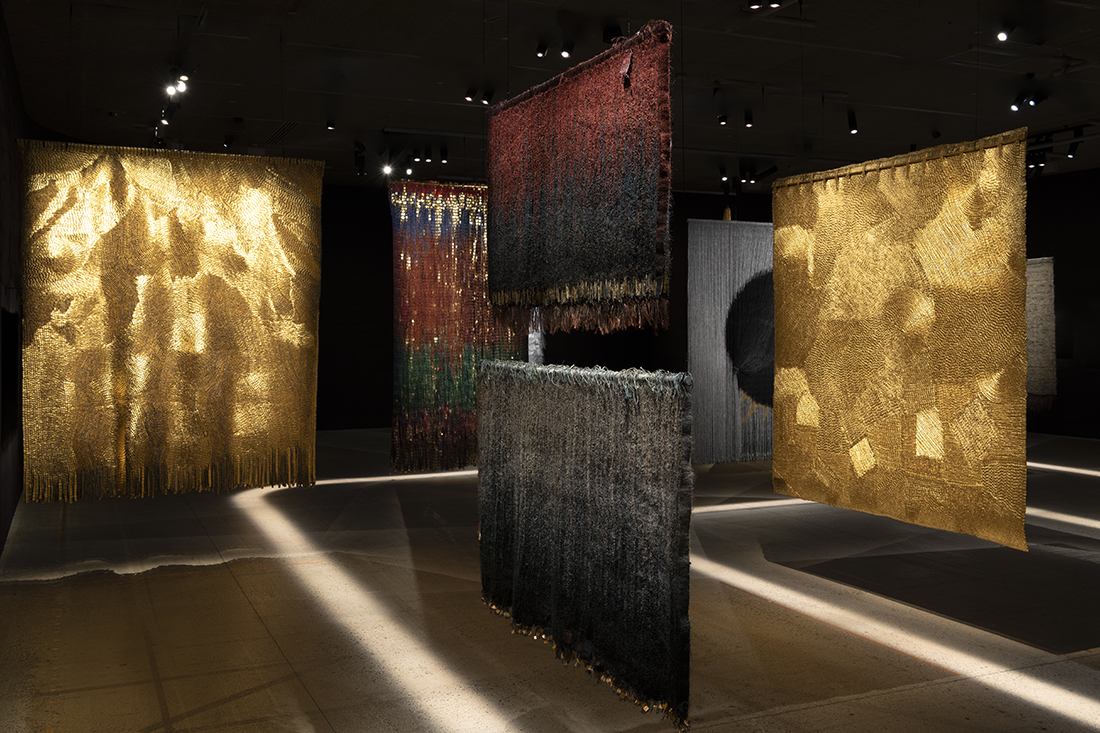
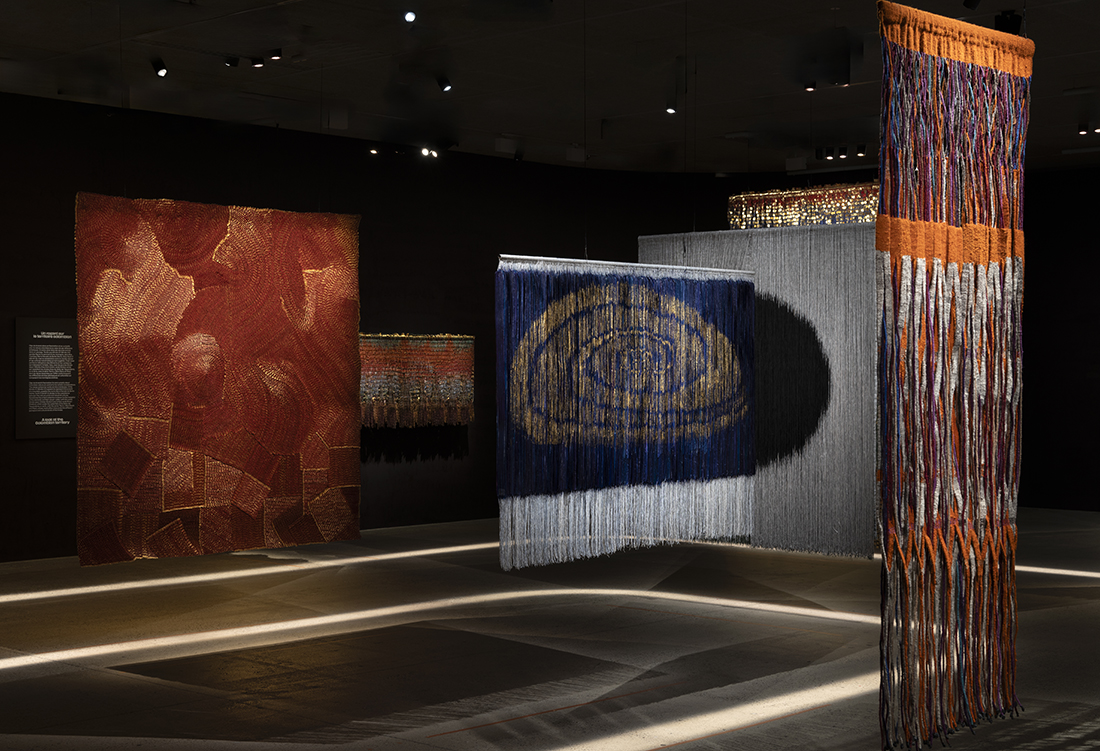
¿Cree que el trabajo de Olga de Amaral redefine la frontera entre el arte textil y la escultura?
¡Sí, por supuesto! La serie Brumas, que Olga comenzó en 2013, es completamente escultórica. Son tejidos tridimensionales, aéreos, con patrones geométricos pintados directamente sobre los hilos de algodón.
¿Do you believe that Olga de Amaral’s work redefines the boundary between textile art and sculpture?
«¡Yes, absolutely! The Brumas series, which Olga began in 2013, is entirely sculptural. These are three-dimensional weavings, airy, with geometric patterns painted directly onto the cotton threads.»
¿Qué motivó a la Fundación Cartier a acoger una exposición de Olga de Amaral?
Descubrimos el trabajo de Olga de Amaral mientras trabajábamos en una exposición titulada Geometrías del Sur hace algunos años. En esa ocasión, presentamos seis obras de la serie Brumas. Cuando las instalamos por primera vez en la Fundación Cartier, fue inmediatamente evidente: la belleza y la sorpresa de estas obras, su diálogo con el edificio, nos hicieron querer dedicar una exposición monográfica a su increíble trabajo.
What motivated the Cartier Foundation to host an exhibition of Olga de Amaral?
We discovered Olga de Amaral’s work while preparing for an exhibition titled Geometries of the South a few years ago. On that occasion, we presented six works from the Brumas series. When we first installed them at the Cartier Foundation, it was immediately clear: the beauty and the surprise of these works, their dialogue with the building, made us want to dedicate a monographic exhibition to her incredible work.
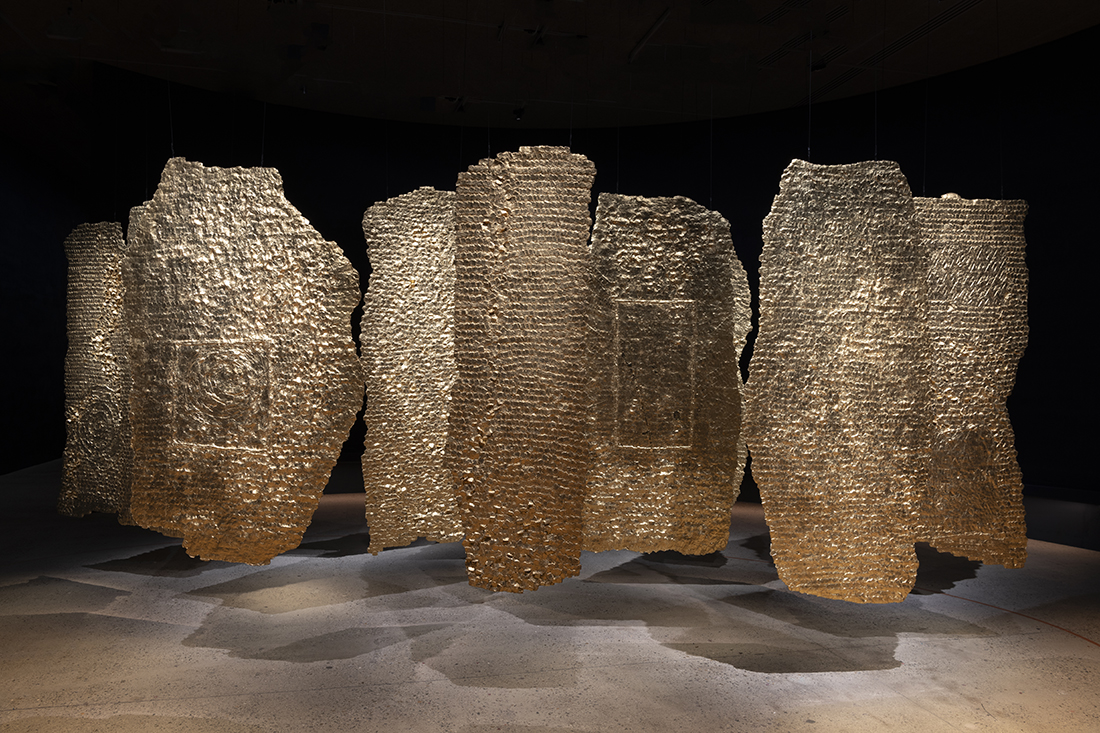
¿Qué tipo de reacción espera del público ante esta exposición, considerando el enfoque único de Olga de Amaral?
Creo que el público nunca ha visto algo como esto. Pienso que todos los visitantes de la Fundación Cartier estarán tan sorprendidos y encantados con el trabajo de Olga como nosotros. La exposición reúne casi 80 obras creadas entre la década de 1960 y hoy. Aunque no es representativa de toda su carrera, esperamos ofrecer una visión de la riqueza y diversidad de su trabajo. Presentamos obras de pequeño formato que se consideran estudios y preludios de otras piezas, mientras que otras son monumentales y dialogan con la arquitectura de la Fundación Cartier.
What kind of reaction do you expect from the public to this exhibition, considering Olga de Amaral’s unique approach?
I believe the public has never seen anything quite like this. I think all visitors to the Cartier Foundation will be as surprised and delighted by Olga’s work as we are. The exhibition brings together nearly 80 works created between the 1960s and today. Although it’s not fully representative of her entire career, we hope to offer a glimpse into the richness and diversity of her work. We present small-format pieces considered studies and preludes to other works, while others are monumental and engage in a dialogue with the architecture of the Cartier Foundation.
12 de octubre, 2024 al 16 de marzo, 2025
Fondation Cartier pour l’art contemporain, París.

